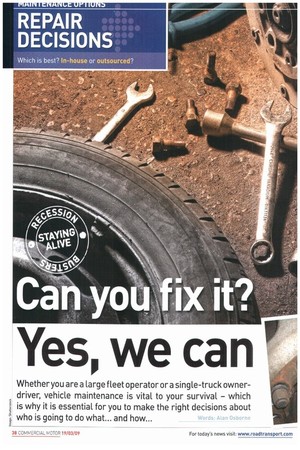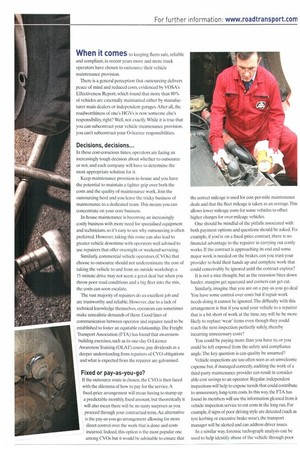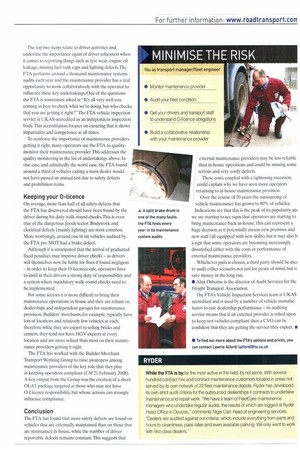Yes, we can
Page 38

Page 39

Page 40

Page 41

If you've noticed an error in this article please click here to report it so we can fix it.
Whetheryou are a large fleet operator or a single-truck ownerdriver, vehicle maintenance is vital to your survival which is why it is essential for you to make the right decisions about
who is going to do what... and how... U5a0file When it comes to keeping fleets safe, reliable and compliant. in recent years more and more truck operators have chosen to outsource their vehicle maintenance provision.
There is a general perception that outsourcing delivers peace of mind and reduced costs, evidenced by VOSA's Effectiveness Report, which found that more than 80% of vehicles are externally maintained either by manufacturer main dealers or independent garages. After all, the roadworthiness of one's HGVs is now someone else's responsibility, right? Well, not exactly. While it is true that you can subcontract your vehicle maintenance provision, you can't subcontract your 0-licence responsibilities.
Decisions, decisions...
In these cost-conscious times, operators are facing an increasingly tough decision about whether to outsourcc or not, and each company will have to determine the most appropriate solution for it.
Keep maintenance provision in-house and you have the potential to maintain a tighter grip over both the costs and the quality of maintenance work. Join the outsourcing herd and you leave the tricky business of maintenance to a dedicated team. This means you can concentrate on your core business.
In-house maintenance is becoming an increasingly costly business with more need for specialised equipment and technicians, so it's easy to see why outsourcing is often preferred. However, taking this route can also lead to greater vehicle downtime with operators well advised to use repairers that offer overnight or weekend servicing.
Similarly, commercial vehicle operators (CVOs) that choose to outsource should not underestimate the cost of taking the vehicle to and from an outside workshop; a 15-minute drive may not seem a great deal but when you throw poor road conditions and a big fleet into the mix, the costs can soon escalate.
The vast majority of repairers do an excellent job and are trustworthy and reliable. However. due to a lack of technical knowledge themselves. operators can sometimes make unrealistic demands of them. Good lines of communication between operator and repairer need to be established to foster an equitable relationship. '[he Freight Transport Association (FFA) has found that awarenessbuilding exercises, such as its one-day 0-Licence AwarenessTraining (OLAT) course, pay dividends as a deeper understanding from repairers of CVO obligations and what is expected from the repairer are galvanised.
Fixed or pay-as-you-go?
If the outsource route is chosen. the CVO is then faced with the dilemma of how to pay for the service. A fixed-price arrangement will mean having to stump up a predictable monthly, fixed amount, but theoretically it will also mean there will be no nasty surprises as you proceed through your contractual term. An alternative is the pay-as-you-go arrangement allowing for more direct control over the work that is done and costs incurred. Indeed, this option is the most popular one among CVOs hut it would be advisable to ensure that the correct mileage is used for cost-per-mile maintenance deals and that the fleet mileage is taken as an average. This allows lower mileage costs for some vehicles to offset higher charges for over-mileage vehicles.
One should be mindful of the pitfalls associated with both payment options and questions should be asked. Foi example, if you're on a fixed-price contract, there is no financial advantage to the repairer in carrying out costly works. If the contract is approaching its end and some major work is needed on the brakes, can you trust your provider to hold their hands up and complete work that could conceivably he ignored until the contract expires?
It is not a nice thought, but as the recession bites down harder, margins get squeezed and corners can get cut.
Similarly, imagine that you are on a pay-as-you-go deal You have some control over costs but if repair work needs doing it cannot be ignored,'The difficulty with this arrangement is that if you send your vehicle to a repairer that is a bit short of work at the time, say, will he be more likely to replace 'wear' items even though they could reach the next inspection perfectly safely, thereby incurring unnecessary costs?
You could be paying more than you have to, or you could be left exposed from the safety and compliance angle. The key question is can quality be assumed?
Vehicle inspections are too often seen as an unwelcome expense but, if managed correctly, auditing the work of a third-party maintenance provider can result in considerable cost savings to an operator. Regular, independent inspections will help to expose trends that could contribute to unnecessary, long-term costs. In this way. the FTA has found its members will use the information gleaned from it vehicle inspection service to cut costs in the long run. For example, if signs of poor driving style are detected (such as tyre kerbing or excessive brake wear), the transport manager will be alerted and can address driver issues.
In a similar way forensic tachograph analysis can be used to help identify abuse of the vehicle through poor driving technique. which will send out a pretty strong message to negligent drivers. Independent checks should also enable unnecessary repair costs and downtime to be avoided by ensuring maintenance providers perform only the required work. If you were to substitute one of these checks periodically for one of the safety inspections conducted by your repairer, the value should be greater.
The FrA has found that more than half of all HGV prohibition items should have been detected by the driver during his daily walk-round checks. Sadly it is clear that with outsourced maintenance provision, individual cases of drivers neglecting their walk-round duties are not always communicated to the transport manager. This is a real missed opportunity as improved driver walk-round checks will reduce the risk of non-compliance and being hauled in front of the Traffic Commissioner significantly.
Based on FTA findings, the quantity of driver-reportable safety defects tends to be the same if vehicles are maintained internally or externally, so maintenance providers are missing a trick. When was the last time that you as an operator had your maintenance provider say: 'I think you have a problem with your daily walk-round procedure as we are seeing things on the vehicles that your driver should be spotting or reporting'?
Spending your money wisely with maintenance providers will reap rewards; get it wrong and you risk incurring the considerable, but sometimes hidden costs of unnecessary repairs, increased targeting by VOSA, downtime at the roadside, having to hire in vehicles, letting your customers down, attending a public inquiry and even having your 0-licence removed.
Techno prisoners
There is certainly no recession in government policy and enforcement where transport operators are concerned.
While it is true that the compliant have nothing to fear from better detection, it may surprise some operators to learn that external maintenance providers can actually jeopardise their Operator Compliance Risk Score (OCRS) without them knowing through initial failure at annual test and handing back non-compliant vehicles. The OCRS has been developed by VOSA as a way of assigning goods and passenger vehicle operators a rating that allows enforcement officers to identify which vehicles are the most likely to be non-compliant. It is used at the roadside and flags operators as having a green, amber or red status, with those that are green the most likely to be compliant and those that are red the least likely. Generally an operator with a red score is more likely to be checked.
An operator's status depends on a roadworthiness score and a traffic enforcement score. These scores are calculated from data collated at previous encounters or annual tests, or in the case of new operators, predictive scores are used. Worryingly, external maintenance providers can and will put a vehicle through tests many times before it passes, which can turn an operator from green to amber and amber to red, without the CVO being made aware of its diminishing status.
Weigh in Motion Systems (WIMS), Automatic Number Plate Recognition cameras (ANPR) and Mobile Compliance Devices (MCDs) linked to VOSA's database all provide real-time intelligence to VOSA to allow it to target non-compliant operators and the evidence is that this approach is proving effective. So operators need to have confidence in their maintenance provider's ability to make sure their vehicles are 100%. After all, it won't be the maintenance provider that has to explain non-compliance to the Traffic Commissioner.
As a further illustration of the need for partnership between the operator and the maintenance provider in general, maintenance providers will sometimes be unaware of the six key practices that Traffic Commissioners have identified as essential for operators to maintain their vehicle compliance and that feature in the VOSA Guide to Maintaining Roadworthiness (available as a free downloadable PDF from the VOSA website: • Daily walk-round checks, and first use inspections • Driver defect reporting • Safety inspections • Maintenance facilities or external arrangements • Quality monitoring • Records
The top two items relate to driver activities and underline the importance again of driver education when it comes to reporting things such as tyre wear, engine oil leakage, missing fuel tank caps and lighting defects .The FTA performs around a thousand maintenance systems audits each year and the maintenance provider has a real opportunity to work collaboratively with the operator to influence these key undertakings. One of the questions the FTA is sometimes asked is: "It's all very well you coming in here to check what we're doing, but who checks that you are getting it right?" The FTA vehicle inspection service is UKAS-accredited as an independent inspection body. This accreditation focuses on ensuring that it shows impartiality and competence at all times.
To reinforce the importance of maintenance providers getting it right, many operators use the FTA to qualitymonitor their maintenance provider.This addresses the quality monitoring in the list of undertakings above. In one case, and admittedly the worst case, the FTA found around a third of vehicles exiting a main dealer would not have passed an annual test due to safety defects and prohibition items.
Keeping your 0-licence
On average, more than half of all safety defects that the FTA has discovered should have been found by the driver during his daily walk-round checks. This is even true of the dangerous goods sector. Bodywork and electrical defects (mainly lighting) are most common. More worryingly, around one in six vehicles audited by the FTA pre-MOT had a brake defect.
Although it is anticipated that the arrival of graduated fixed penalties may improve driver checks — as drivers will themselves now be liable for fines if found negligent — in order to keep their 0-licences safe, operators have to instil in their drivers a strong duty of responsibility and a system where mandatory walk-round checks need to be implemented.
For some sectors it is more difficult to bring their maintenance operations in-house and they are reliant on dealerships and independent garages for maintenance provision. Builders' merchants, for example. typically have lots of locations and relatively few vehicles at each, therefore while they are expert in selling bricks and cement, they tend not have HGV experts at every location and are more reliant than most on their maintenance providers getting it right.
The FTA has worked with the Builder Merchant Transport Working Group to raise awareness among maintenance providers of the key role that they play in keeping operators compliant (CM 21 February 2008). A key output from the Group was the creation of a short OLAT package targeted at those who may not have 0-Licence responsibility, but whose actions can strongly influence compliance.
Conclusion
The VIA has found that more safety defects are found on vehicles that are externally maintained than on those that are maintained in-house, while the number of driver reportable defects remains constant.This suggests that external maintenance providers may be less reliable than in-house operations and could be missing some serious and very costly defects.
These costs. coupled with a tightening recession, could explain why we have seen more operators returning to in-house maintenance provision.
Over the course of 20 years the outsourcing of vehicle maintenance has grown to 80% of vehicles. Indications are that this is the peak of its popularity am we are starting to see signs that operators are starting to bring maintenance back in-house. This can represent a huge decision as it potentially means new premises and new staff (all equipped with new skills), but it may also b a sign that some operators are becoming increasingly dissatisfied either with the costs or performance of external maintenance providers.
Whichever path is chosen, a third party should he use( to audit either scenario, not just for peace of mind, hut tc save money in the long run.
• Alan Osborne is the director of Audit Services for the Freight Transport Association.
The FTA's Vehicle Inspection Services team is UKAS accredited and is used by a number of vehicle manufacturers to rate dealership performance — its auditing service means that if an external provider is relied upon to keep test vehicles compliant then a CVO can be confident that they are getting the service they expect. •
• To find out more about the ETA's options and prices, you can contact Lawrie Alford: lalfordlafta.co.uk
















































































































































